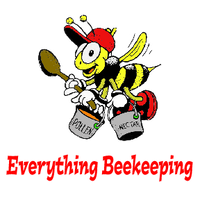Regal Renewal: How to Requeen Your Beehive!
Posted by Wayne Flewelling on
👑🐝 Regal Renewal: How to Requeen Your Beehive! 🐝👑
Hello, beekeeping enthusiasts and hive keepers! 🌼🏕️ If you're noticing signs of a declining hive or an aging queen, it might be time for a royal renewal! Requeening your beehive is a crucial step in maintaining a strong and healthy colony. Let's explore the process of requeening and how to ensure a smooth transition for your buzzing residents! 👑🐝
👉 Step 1: Assess the Need for Requeening
Keep a close eye on your hive's performance and behavior. Signs of a failing queen include reduced brood production, a decline in population, or inconsistent egg-laying patterns. Aggressive or unusually defensive behavior can also indicate the need for requeening. Perform regular hive inspections to stay proactive!
👉 Step 2: Prepare the New Queen
Acquire a healthy and mated queen from a reputable breeder or supplier. Introducing a young and vigorous queen ensures the hive's future productivity and vitality. Keep the new queen in a queen cage, accompanied by a few attendants. This cage allows the bees to gradually accept their new leader.
👉 Step 3: Choose the Right Time
Select a calm and warm day for the requeening process. Avoid requeening during periods of dearth or extreme weather conditions, as it can stress the hive.
👉 Step 4: Introduce the New Queen
Locate the existing queen (if she's still present) and remove her gently from the hive. Place the new queen cage, with attendants, between two brood frames. The bees will become familiar with her pheromones and presence.
👉 Step 5: Monitor the Hive
Check the hive after a few days to see if the bees have accepted the new queen. Observe their behavior; if the bees are calmly surrounding the queen cage and not displaying aggression, it's a positive sign. After about a week, release the new queen from her cage if all indications are positive.
👉 Step 6: Monitor the Transition
During the next few weeks, closely monitor the hive's progress. Observe egg-laying patterns and the overall health of the colony. It might take some time for the hive to fully adjust to the new queen's pheromones, but patience is key.
👉 Step 7: Supportive Measures
In some cases, the hive may need extra support during the requeening process. Provide additional food sources, such as sugar syrup or pollen patties, to strengthen the hive and help it through this transitional phase.
🌼 Requeening a hive is a delicate but essential process in beekeeping. With careful planning, observation, and support, you can successfully introduce a new queen and ensure the thriving future of your beehive. Let's keep our buzzing friends happy and healthy! 🏕️🐝👑
#BeekeepingTips #RequeeningProcess #BeekeeperCommunity #HealthyHives #Everythingbeekeeping 🌼👑🐝
Hello, beekeeping enthusiasts and hive keepers! 🌼🏕️ If you're noticing signs of a declining hive or an aging queen, it might be time for a royal renewal! Requeening your beehive is a crucial step in maintaining a strong and healthy colony. Let's explore the process of requeening and how to ensure a smooth transition for your buzzing residents! 👑🐝
👉 Step 1: Assess the Need for Requeening
Keep a close eye on your hive's performance and behavior. Signs of a failing queen include reduced brood production, a decline in population, or inconsistent egg-laying patterns. Aggressive or unusually defensive behavior can also indicate the need for requeening. Perform regular hive inspections to stay proactive!
👉 Step 2: Prepare the New Queen
Acquire a healthy and mated queen from a reputable breeder or supplier. Introducing a young and vigorous queen ensures the hive's future productivity and vitality. Keep the new queen in a queen cage, accompanied by a few attendants. This cage allows the bees to gradually accept their new leader.
👉 Step 3: Choose the Right Time
Select a calm and warm day for the requeening process. Avoid requeening during periods of dearth or extreme weather conditions, as it can stress the hive.
👉 Step 4: Introduce the New Queen
Locate the existing queen (if she's still present) and remove her gently from the hive. Place the new queen cage, with attendants, between two brood frames. The bees will become familiar with her pheromones and presence.
👉 Step 5: Monitor the Hive
Check the hive after a few days to see if the bees have accepted the new queen. Observe their behavior; if the bees are calmly surrounding the queen cage and not displaying aggression, it's a positive sign. After about a week, release the new queen from her cage if all indications are positive.
👉 Step 6: Monitor the Transition
During the next few weeks, closely monitor the hive's progress. Observe egg-laying patterns and the overall health of the colony. It might take some time for the hive to fully adjust to the new queen's pheromones, but patience is key.
👉 Step 7: Supportive Measures
In some cases, the hive may need extra support during the requeening process. Provide additional food sources, such as sugar syrup or pollen patties, to strengthen the hive and help it through this transitional phase.
🌼 Requeening a hive is a delicate but essential process in beekeeping. With careful planning, observation, and support, you can successfully introduce a new queen and ensure the thriving future of your beehive. Let's keep our buzzing friends happy and healthy! 🏕️🐝👑
#BeekeepingTips #RequeeningProcess #BeekeeperCommunity #HealthyHives #Everythingbeekeeping 🌼👑🐝
